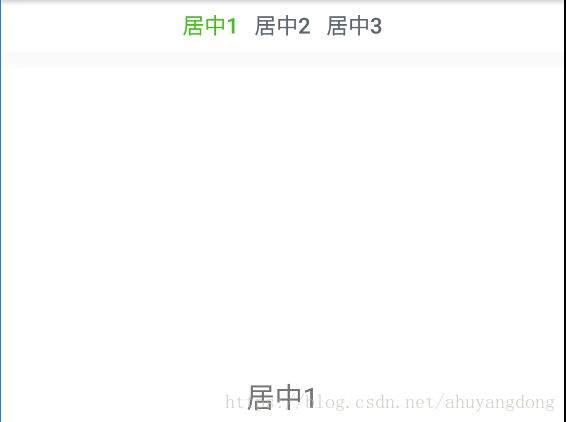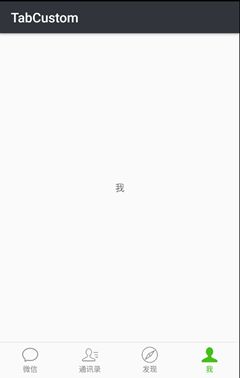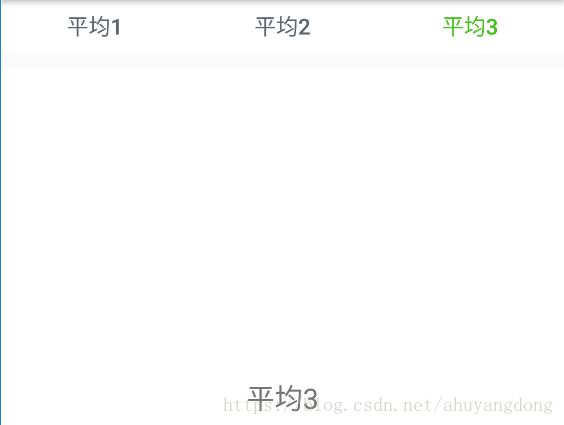Android仿微信底部菜单栏+今日头条顶部导航栏
背景
Android应用几乎都会用到底部菜单栏,在Material Design还没有出来之前,TabHost等技术一直占主流,现在Google新sdk中提供了TabLayout类可以便捷的做出底部菜单栏效果。
本节我们实现两种主要的Tab效果:
- 仿微信底部菜单
- 仿今日头条顶部导航条
底部菜单
Tab一般与Activity或Fragment配合使用,以达到多页面切换效果,这里使用Fragment来开发子界面。
微信形式的底部菜单可以理解为一个外层Activity,套用几个Fragment。页面布局层次为:
- MainActivity 主框架
- MsgFragment 微信
- ContactFragment 通讯录
- FindFragment 发现
- MeFragment 我
1、activity_main.xml布局
ViewPager+TabLayout上下结构:
<LinearLayout xmlns:android="http://schemas.android.com/apk/res/android"
xmlns:app="http://schemas.android.com/apk/res-auto"
xmlns:tools="http://schemas.android.com/tools"
android:layout_width="match_parent"
android:layout_height="match_parent"
android:orientation="vertical"
tools:context=".MainActivity">
<android.support.v4.view.ViewPager
android:id="@+id/view_pager"
android:layout_width="match_parent"
android:layout_height="0dip"
android:layout_weight="1" />
<View
android:layout_width="match_parent"
android:layout_height="0.5dip"
android:background="@color/line_gray" />
<android.support.design.widget.TabLayout
android:id="@+id/tab_layout"
android:layout_width="match_parent"
android:layout_height="54dip"
app:tabIndicatorHeight="0dip" />
LinearLayout>
2、MainActivity源码
package com.dommy.tab;
import android.os.Bundle;
import android.support.design.widget.Snackbar;
import android.support.design.widget.TabLayout;
import android.support.v4.view.PagerAdapter;
import android.support.v4.view.ViewPager;
import android.support.v7.app.AppCompatActivity;
import android.view.KeyEvent;
import android.view.LayoutInflater;
import android.view.View;
import android.widget.ImageView;
import android.widget.TextView;
import com.dommy.tab.adapter.MainFragmentAdapter;
import butterknife.BindView;
import butterknife.ButterKnife;
/**
* 主框架
*/
public class MainActivity extends AppCompatActivity {
/**
* 菜单标题
*/
private final int[] TAB_TITLES = new int[]{R.string.menu_msg, R.string.menu_contact, R.string.menu_find, R.string.menu_me};
/**
* 菜单图标
*/
private final int[] TAB_IMGS = new int[]{R.drawable.tab_main_msg_selector, R.drawable.tab_main_contact_selector, R.drawable.tab_main_find_selector
, R.drawable.tab_main_me_selector};
@BindView(R.id.view_pager)
ViewPager viewPager;
@BindView(R.id.tab_layout)
TabLayout tabLayout;
/**
* 页卡适配器
*/
private PagerAdapter adapter;
@Override
protected void onCreate(Bundle savedInstanceState) {
super.onCreate(savedInstanceState);
setContentView(R.layout.activity_main);
ButterKnife.bind(this);
// 初始化页卡
initPager();
setTabs(tabLayout, getLayoutInflater(), TAB_TITLES, TAB_IMGS);
}
/**
* 设置页卡显示效果
* @param tabLayout
* @param inflater
* @param tabTitlees
* @param tabImgs
*/
private void setTabs(TabLayout tabLayout, LayoutInflater inflater, int[] tabTitlees, int[] tabImgs) {
for (int i = 0; i < tabImgs.length; i++) {
TabLayout.Tab tab = tabLayout.newTab();
View view = inflater.inflate(R.layout.item_main_menu, null);
// 使用自定义视图,目的是为了便于修改,也可使用自带的视图
tab.setCustomView(view);
TextView tvTitle = (TextView) view.findViewById(R.id.txt_tab);
tvTitle.setText(tabTitlees[i]);
ImageView imgTab = (ImageView) view.findViewById(R.id.img_tab);
imgTab.setImageResource(tabImgs[i]);
tabLayout.addTab(tab);
}
}
private void initPager() {
adapter = new MainFragmentAdapter(getSupportFragmentManager());
viewPager.setAdapter(adapter);
// 关联切换
viewPager.addOnPageChangeListener(new TabLayout.TabLayoutOnPageChangeListener(tabLayout));
tabLayout.addOnTabSelectedListener(new TabLayout.OnTabSelectedListener() {
@Override
public void onTabSelected(TabLayout.Tab tab) {
// 取消平滑切换
viewPager.setCurrentItem(tab.getPosition(), false);
}
@Override
public void onTabUnselected(TabLayout.Tab tab) {
}
@Override
public void onTabReselected(TabLayout.Tab tab) {
}
});
}
}
源码说明:
- 绑定视图对象使用到了ButterKnife框架;
- viewPager和tabLayout添加了事件互相绑定,这样viewPager的滑动和tab的切换都能相互影响;
- setTabs方法设置tabLayout内部的具体内容,为界面中的TabLayout添加了四个子Tab视图。
- Tab的内容使用到了自定义视图,比较灵活一点,也可以使用Tab自带的布局结构。
3、Tab自定义视图item_main_menu.xml
自定义视图包含一个上方图标和下方的文字,使用自定义视图的好处就是图标大小方便修改,文字颜色啥的都好改,比较随心。
<LinearLayout xmlns:android="http://schemas.android.com/apk/res/android"
android:layout_width="match_parent"
android:layout_height="match_parent"
android:gravity="center_horizontal"
android:orientation="vertical">
<ImageView
android:id="@+id/img_tab"
android:layout_width="24dip"
android:layout_height="24dip"
android:src="@drawable/menu_msg_default" />
<TextView
android:id="@+id/txt_tab"
android:layout_width="wrap_content"
android:layout_height="wrap_content"
android:layout_marginTop="2dip"
android:text="首页"
android:textColor="@drawable/txt_main_menu_selector"
android:textSize="11sp" />
LinearLayout>
4、Tab图标selector
以第一个Tab“微信”使用的图标为例,tab_main_msg_selector.xml内容:
<selector xmlns:android="http://schemas.android.com/apk/res/android">
<item android:drawable="@drawable/menu_msg_selected" android:state_pressed="true" />
<item android:drawable="@drawable/menu_msg_selected" android:state_selected="true" />
<item android:drawable="@drawable/menu_msg_default" />
selector>
使用到了两张图片:menu_msg_default、menu_msg_selected,一张默认图样式,一张选中图样式,对比如下:


5、Tab文字selector
因为Tab选中时需要做区分,所以文字颜色与图标一起变动会更好看,文字颜色也需要写selector。txt_main_menu_selector.xml:
<selector xmlns:android="http://schemas.android.com/apk/res/android">
<item android:color="@color/menu_green" android:state_selected="true">item>
<item android:color="@color/menu_gray">item>
selector>
menu_gray是默认状态的灰色,menu_green是选中时呈现的绿色。
6、页面切换Adapter
页面切换内容由viewPager的adapter对象完成,使用Fragment作为子页面时,adapter需要是FragmentPagerAdapter的实例,所以上述代码中的MainFragmentAdapter源码为:
package com.dommy.tab.adapter;
import android.support.v4.app.Fragment;
import android.support.v4.app.FragmentManager;
import android.support.v4.app.FragmentPagerAdapter;
import com.dommy.tab.fragment.ContactFragment;
import com.dommy.tab.fragment.FindFragment;
import com.dommy.tab.fragment.MeFragment;
import com.dommy.tab.fragment.MsgFragment;
/**
* 主界面底部菜单适配器
*/
public class MainFragmentAdapter extends FragmentPagerAdapter {
public MainFragmentAdapter(FragmentManager fm) {
super(fm);
}
@Override
public Fragment getItem(int i) {
Fragment fragment = null;
switch (i) {
case 0:
fragment = new MsgFragment();
break;
case 1:
fragment = new ContactFragment();
break;
case 2:
fragment = new FindFragment();
break;
case 3:
fragment = new MeFragment();
break;
default:
break;
}
return fragment;
}
@Override
public int getCount() {
return 4;
}
}
说明:
- getItem返回具体位置的viewPager切换到i位置时对应的fragment,因为主框架的视图是固定的,所以在这里根据i的值返回对应的fragment对象即可;
- getItem中返回的fragment也可以携带一些参数,如果需要的话;
- getCount返回视图的总数量,这里是固定值4。
7、子页面示例
本例中的子页面只是呈现一个简单的文字,实际开发中根据需要写入相应布局和功能替换即可。这里以MeFragment作为示例:
MeFragment.java:
package com.dommy.tab.fragment;
import android.os.Bundle;
import android.support.v4.app.Fragment;
import android.view.LayoutInflater;
import android.view.View;
import android.view.ViewGroup;
import com.dommy.tab.R;
/**
* 我
*/
public class MeFragment extends Fragment {
public MeFragment() {
}
@Override
public View onCreateView(LayoutInflater inflater, ViewGroup container,
Bundle savedInstanceState) {
return inflater.inflate(R.layout.fragment_me, container, false);
}
}
fragment_me.xml:
<RelativeLayout xmlns:android="http://schemas.android.com/apk/res/android"
xmlns:tools="http://schemas.android.com/tools"
android:layout_width="match_parent"
android:layout_height="match_parent"
tools:context=".fragment.MeFragment">
<TextView
android:layout_width="wrap_content"
android:layout_height="wrap_content"
android:layout_centerInParent="true"
android:text="我" />
RelativeLayout>
8、小结
MainActivity作为主框架,使用ViewPager实现4个子页面Fragment的切换,使用TabLayout绑定ViewPager来切换视图,实现了Tab卡切换、ViewPager滑动页面的效果,基本实现了微信主框架的效果。
顶部导航条
TabLayout放在顶部的时候,加上一些属性配置,就可以完美实现顶部导航的效果。根据导航条样式,这里分为三类:
- 自适应非固定条数形式;
- 居中固定条数形式;
- 平铺固定条数形式。
现就三种效果分别展开,读者可以根据需要选用相应的方法。
自适应非固定条数
这种就是和今日头条类似的形式,适用于顶部菜单数量不固定,而且比较多的情况。
从左至右依次排放,每个菜单的内容均完全显示,长度根据内容自动伸缩,超长后的菜单需要滚动显示。
为了方便,源码写在了MsgFragment中,也就是第一个子页面“微信”中。
1、MsgFragment.java
布局结构与MainActivity有类似之处。
package com.dommy.tab.fragment;
import android.os.Bundle;
import android.support.annotation.Nullable;
import android.support.design.widget.TabLayout;
import android.support.v4.app.Fragment;
import android.support.v4.view.ViewPager;
import android.view.LayoutInflater;
import android.view.View;
import android.view.ViewGroup;
import com.dommy.tab.R;
import com.dommy.tab.adapter.MsgContentFragmentAdapter;
import java.util.ArrayList;
import java.util.List;
import butterknife.BindView;
import butterknife.ButterKnife;
/**
* 消息
* 在这个界面中实现类似今日头条的头部tab
*/
public class MsgFragment extends Fragment {
@BindView(R.id.tab_layout)
TabLayout tabLayout;
@BindView(R.id.view_pager)
ViewPager viewPager;
private MsgContentFragmentAdapter adapter;
private List<String> names;
@Override
public void onCreate(@Nullable Bundle savedInstanceState) {
super.onCreate(savedInstanceState);
initData();
}
@Override
public View onCreateView(LayoutInflater inflater, ViewGroup container,
Bundle savedInstanceState) {
View view = inflater.inflate(R.layout.fragment_msg, container, false);
ButterKnife.bind(this, view);
adapter = new MsgContentFragmentAdapter(getChildFragmentManager());
viewPager.setAdapter(adapter);
tabLayout.setupWithViewPager(viewPager);
// 更新适配器数据
adapter.setList(names);
return view;
}
private void initData() {
names = new ArrayList<>();
names.add("关注");
names.add("推荐");
names.add("热点");
names.add("视频");
names.add("小说");
names.add("娱乐");
names.add("问答");
names.add("图片");
names.add("科技");
names.add("懂车帝");
names.add("体育");
names.add("财经");
names.add("军事");
names.add("国际");
names.add("健康");
}
}
2、fragment_msg.xml
布局有主界面比较相似,不过TabLayout被放在顶部了。
<LinearLayout xmlns:android="http://schemas.android.com/apk/res/android"
xmlns:app="http://schemas.android.com/apk/res-auto"
xmlns:tools="http://schemas.android.com/tools"
android:layout_width="match_parent"
android:layout_height="match_parent"
android:orientation="vertical"
tools:context=".fragment.MsgFragment">
<android.support.design.widget.TabLayout
android:id="@+id/tab_layout"
android:layout_width="match_parent"
android:layout_height="34dip"
app:tabBackground="@color/white"
app:tabIndicatorColor="@color/menu_green"
app:tabIndicatorHeight="1dip"
app:tabMode="scrollable"
app:tabMinWidth="40dip"
app:tabPaddingStart="5dip"
app:tabPaddingEnd="5dip"
app:tabSelectedTextColor="@color/wx_head_selected"
app:tabTextAppearance="@style/tab_head"
app:tabTextColor="@color/wx_head_default" />
<android.support.v4.view.ViewPager
android:id="@+id/view_pager"
android:layout_width="match_parent"
android:layout_height="match_parent"
android:layout_marginTop="10dip"
android:layout_weight="1"
android:background="@color/white" />
LinearLayout>
说明:
app:tabMode=“scrollable”
tabMode的值设为scrollable,表示tab卡过多时自动滑动。
3、MsgContentFragmentAdapter
因为内容页大多近似,所以采用同一个Fragment布局即可,内容根据传参来修改。MsgContentFragmentAdapter.java:
package com.dommy.tab.adapter;
import android.os.Bundle;
import android.support.v4.app.Fragment;
import android.support.v4.app.FragmentManager;
import android.support.v4.app.FragmentPagerAdapter;
import com.dommy.tab.fragment.MsgContentFragment;
import java.util.ArrayList;
import java.util.List;
/**
* 消息内容子页面适配器
*/
public class MsgContentFragmentAdapter extends FragmentPagerAdapter {
private List<String> names;
public MsgContentFragmentAdapter(FragmentManager fm) {
super(fm);
this.names = new ArrayList<>();
}
/**
* 数据列表
*
* @param datas
*/
public void setList(List<String> datas) {
this.names.clear();
this.names.addAll(datas);
notifyDataSetChanged();
}
@Override
public Fragment getItem(int position) {
MsgContentFragment fragment = new MsgContentFragment();
Bundle bundle = new Bundle();
bundle.putString("name", names.get(position));
fragment.setArguments(bundle);
return fragment;
}
@Override
public int getCount() {
return names.size();
}
@Override
public CharSequence getPageTitle(int position) {
String plateName = names.get(position);
if (plateName == null) {
plateName = "";
} else if (plateName.length() > 15) {
plateName = plateName.substring(0, 15) + "...";
}
return plateName;
}
}
4、MsgContentFragment
子页面只放了一个TextView用来显示参数,MsgContentFragment.java:
package com.dommy.tab.fragment;
import android.os.Bundle;
import android.support.annotation.Nullable;
import android.support.v4.app.Fragment;
import android.view.LayoutInflater;
import android.view.View;
import android.view.ViewGroup;
import android.widget.TextView;
import com.dommy.tab.R;
import butterknife.BindView;
import butterknife.ButterKnife;
/**
* 消息内容页
*/
public class MsgContentFragment extends Fragment {
@BindView(R.id.txt_content)
TextView tvContent;
private String name;
@Override
public void onCreate(@Nullable Bundle savedInstanceState) {
super.onCreate(savedInstanceState);
Bundle bundle = getArguments();
name = bundle.getString("name");
if (name == null) {
name = "参数非法";
}
}
@Override
public View onCreateView(LayoutInflater inflater, ViewGroup container,
Bundle savedInstanceState) {
View view = inflater.inflate(R.layout.fragment_msg_content, container, false);
ButterKnife.bind(this, view);
tvContent.setText(name);
return view;
}
}
页面布局fragment_msg_content.xml:
<RelativeLayout xmlns:android="http://schemas.android.com/apk/res/android"
xmlns:tools="http://schemas.android.com/tools"
android:layout_width="match_parent"
android:layout_height="match_parent"
tools:context=".fragment.MsgContentFragment">
<TextView
android:id="@+id/txt_content"
android:layout_width="wrap_content"
android:layout_height="wrap_content"
android:layout_centerInParent="true"
android:text="@string/hello_blank_fragment"
android:textSize="18sp" />
RelativeLayout>
居中固定条数
这种形式的导航栏位于水平居中位置,适用于顶部菜单数量较少的情况。
从左至右依次排放,菜单整体位于水平居中位置,因为数量较少,一般不会滚动显示。
看下效果:

由于界面构建原理与上述内容一致,在此仅说明不同之处:
<LinearLayout xmlns:android="http://schemas.android.com/apk/res/android"
xmlns:app="http://schemas.android.com/apk/res-auto"
xmlns:tools="http://schemas.android.com/tools"
android:layout_width="match_parent"
android:layout_height="match_parent"
android:orientation="vertical"
tools:context=".fragment.ContactFragment">
<android.support.design.widget.TabLayout
android:id="@+id/tab_layout"
android:layout_width="match_parent"
android:layout_height="34dip"
android:background="@color/white"
app:tabBackground="@color/white"
app:tabGravity="center"
app:tabIndicatorHeight="0dip"
app:tabMinWidth="40dip"
app:tabMode="fixed"
app:tabPaddingEnd="5dip"
app:tabPaddingStart="5dip"
app:tabSelectedTextColor="@color/wx_head_selected"
app:tabTextAppearance="@style/tab_head"
app:tabTextColor="@color/wx_head_default" />
<android.support.v4.view.ViewPager
android:id="@+id/view_pager"
android:layout_width="match_parent"
android:layout_height="match_parent"
android:layout_marginTop="10dip"
android:layout_weight="1"
android:background="@color/white" />
LinearLayout>
TabLayout有两个属性与“自适应非固定条数”形式不一样:
app:tabMode=“fixed”
tabMode的值设置为fixed(默认值,也可以不加该属性),表示TabLayout的内容最大长度不会超过自身长度,也就是说不会出现滚动条,添加这个属性时,如果Tab过多,则会比较挤,出现Tab内部内容换行的情况。
app:tabGravity=“center”
tabGravity定义Tab内部的对齐方式,当该属性值为center时,表示居中对齐,不进行拉伸,根据Tab内容自适应宽度。
平铺固定条数
Tab平均分配宽度,适用于顶部菜单数量固定,且需要撑满页面的情况。
从左至右依次排放,菜单内容填满整个TabLayout控件,不会滚动显示。
在此仅说明不同之处:
<LinearLayout xmlns:android="http://schemas.android.com/apk/res/android"
xmlns:app="http://schemas.android.com/apk/res-auto"
xmlns:tools="http://schemas.android.com/tools"
android:layout_width="match_parent"
android:layout_height="match_parent"
android:orientation="vertical"
tools:context=".fragment.FindFragment">
<android.support.design.widget.TabLayout
android:id="@+id/tab_layout"
android:layout_width="match_parent"
android:layout_height="34dip"
android:background="@color/white"
app:tabBackground="@color/white"
app:tabGravity="fill"
app:tabIndicatorHeight="0dip"
app:tabMinWidth="40dip"
app:tabMode="fixed"
app:tabPaddingEnd="5dip"
app:tabPaddingStart="5dip"
app:tabSelectedTextColor="@color/wx_head_selected"
app:tabTextAppearance="@style/tab_head"
app:tabTextColor="@color/wx_head_default" />
<android.support.v4.view.ViewPager
android:id="@+id/view_pager"
android:layout_width="match_parent"
android:layout_height="match_parent"
android:layout_marginTop="10dip"
android:layout_weight="1"
android:background="@color/white" />
LinearLayout>
TabLayout有一个属性与“居中固定条数”形式不一样:
app:tabGravity=“fill”
tabGravity定义Tab内部的对齐方式,当该属性值为fill时,表示填充宽度,会进行拉伸,根据Tab数量平均分配每个Tab的宽度。
总结
TabLayout的出现基本解决了以前Android开发遇到的Tab页卡效果不好、不流畅的问题,而且TabLayout还添加了Indicator,能够随手指滑动,修改起来也比较方便。
除了没有直接解决滑动过程中颜色渐变、过渡的问题,普通场景使用TabLayout这个控件已经可以满足需求了。
源码
https://github.com/ahuyangdong/TabCustom
CSDN下载:
https://download.csdn.net/download/ahuyangdong/10722882




